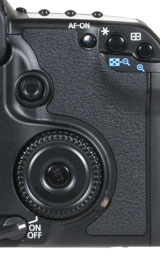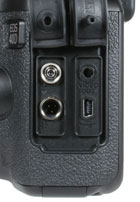Canon EOS 40D
-
-
Written by Gordon Laing
Canon EOS 40D design and build quality
Canon’s EOS 40D greatly resembles its predecessor at first glance. It’s virtually the same size and viewed from the front there’s only subtle differences in the head section to tell them apart. Turn both cameras around though and the new 40D is easily identifiable thanks to its bigger 3in colour monitor – and the rearrangement of buttons to accommodate it.
Measuring 146x108x74mm and weighing 822g, the EOS 40D is only a few millimetres smaller and 70g lighter than the full-frame EOS 5D when both are fitted with their batteries. We’ve pictured both bodies below, fitted with the Canon EF 85mm f1.8 lens; the 40D is on the left and the 5D on the right.
In your hand, the EOS 40D feels very similar to the 5D. Viewed from above (in the shot below: 40D left, 5D right), the grips are virtually identical, as are the resting areas on the back for your thumb. The mottled rubber coating around the grip and rear of the body are also the same as are the positions of the upper controls.
 |
There are however several key differences between the two bodies as seen from above. Starting from the left side, the EOS 40D’s command dial features both the standard creative modes along with a number of scene presets, whereas the EOS 5D only has the former.
 |
Unlike the EOS 5D, the 40D also features a popup flash which contributes to its different head shape. Both models of course have flash hotshoes, but the 40D’s additionally features a plastic surround which works with models like the latest Speedlite 580 EX II to provide greater environmental sealing.
 |
The 40D’s secondary information screen may look similar to its predecessor and the 5D, but is slightly narrower and taller, which with a rearrangement of characters, allows it to squeeze in the ISO value at all times – thanks Canon!
Just before you think the 5D has no advantages in this section, one difference which isn’t apparent from the photo is the type of shutter release: the 5D features a classier soft-touch release like the 1D series, which doesn’t click like the 40D’s when fully depressed.
In terms of build quality, the EOS 40D feels essentially the same as the earlier EOS 30D and EOS 5D models. With their magnesium alloy bodies, all three feel very solid and tough in your hands, and are a step-up from cheaper consumer DSLRs like the Nikon D80.
 |
As far as weather-proofing is concerned, the EOS 40D is by no means waterproof, but features enhancements over both the 30D and 5D: most notably the doors on the memory card and battery compartments now feature thin rubber strips around their perimeters to provide better sealing against the elements – see photo.
Like the earlier models, the ports are also covered by thick rubber flaps – see below. As we mentioned earlier, the 40D’s flash hotshoe also features weather-proofing when used with a modern Speedlite like the 580 EX II.
 |
Round the back, the EOS 40D will be immediately familiar to owners of either the 30D or 5D, with only a few adjustments to accommodate the bigger screen. The lower right side is still dominated by a thumb wheel which provides very quick and tactile adjustments of settings along with a reassuringly big SET button in the middle – this can be configured in the Custom Settings menus to provide direct access to certain settings and is also used to fire-up the 40D’s Live View mode, if the feature’s been enabled.
To the upper left of the wheel is an eight-way joystick which can be used for scrolling round images or as an alternative to the thumb and finger dials when navigating menus and other options. Like earlier EOS DSLRs, it requires a little practice to avoid pressing it, say, upwards, when you meant to push it in to confirm a setting. A new and welcome addition to the rear controls is the AF-ON button, which can be used to start the AF independently of the shutter release; it’s also used for AF during Live View, but again only if the AF support in Live View is enabled in the menus. For more details on Live View, see our Features pages.
Buttons which were to the left of the 2.5in screen on the EOS 30D and 5D now find themselves repositioned above or below the screen. One new addition is a button offering direct access to the 40D’s Picture Styles menu. Speaking of direct access, the 40D offers buttons which let you adjust most of the common settings, but like earlier EOS DSLRs, there’s no button dedicated to the resolution or compression. Instead you’ll need to enter the menu system, or configure the SET button to present this page.
Canon EOS 40D flash
 |
 |
The EOS 40D features a built-in flash which can popup by itself in the fully automatic modes, or at a push of a button in other modes. Like its predecessor this internal flash is flickered for AF assistance. The 40D’s fastest flash sync speed is 1/250 and the internal flash has a guide number of 13m at 100 ISO. There’s a hotshoe with support for greater environmental sealing and a PC Sync port for studio lighting – see ports section below.
 |
The 40D features a dedicated page of options for the internal flash which allow you to set the curtain sync, compensation and E-TTL II mode. Impressively the 40D now also offers direct in-camera control over the functions of compatible Speedlites like the 580 EX II, allowing you to adjust the compensation, bracketing, sync and zoom modes.
Canon EOS 40D connectivity
 |
On the 40D’s left side are two large rubber flaps hiding the same four ports as the 5D (albeit with two curiously swapped round). The left flap hides the PC Sync port for external lighting and a terminal for N3-type cable releases.
Behind the right flap are the video out and USB ports. The latter can be used with supplied software to remote control the 40D and even preview and focus the shot in Live View mode – see Features pages for more information.
Underneath the 40D is an additional connector for the optional WFT-E3(A) wireless transmitter.
NEW: see our Canon WFT-E3(A) review.
Canon EOS 40D battery
The Canon EOS 40D is powered by the same BP-511A Lithium Ion pack as its predecessor and the EOS 5D. Canon claims the battery is good for up to 800 shots with viewfinder composition and 50% flash usage at temperatures of 23 degrees Celsius. Switch to Live View for exclusive composition and this number falls to around 170 shots.
Obviously the battery life greatly depends on your usage, but we typically managed around 600 shots per charge with a mixture of flash and Live View use, along with several long exposures in cold temperatures. If you’d like extended shooting time, you can fit the optional BG-E2N battery grip which can take two battery packs and also provides a portrait grip.




